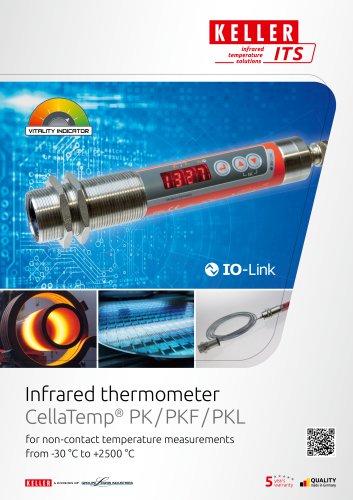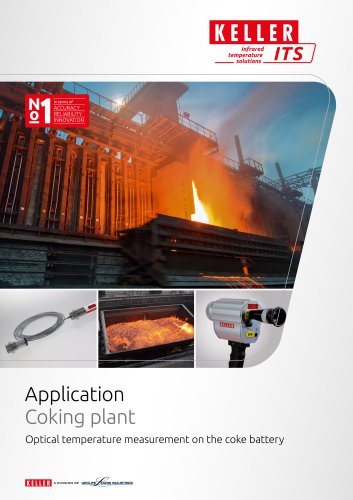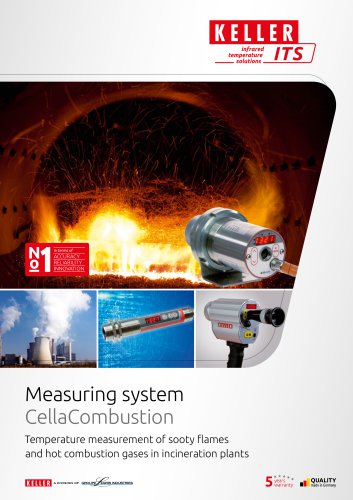 Website:
Keller ITS (Infrared Temperature Solutions)
Website:
Keller ITS (Infrared Temperature Solutions)
Grupo: Legris Industries
Excertos do catálogo

TECHNICAL REPORTS Temperature Measurement in Induction Heating Applications – Methods and Innovations by Albert Book Advanced induction heating systems are widely employed Pyrometers are used to measure tempera- in today’s forging industry for hot-forging applications. Prior to tures in induction heating processes. One forging, steel is heated to a temperature between 1000 °C and can choose between single-wavelength and 1250 °C. The required process temperature depends on the dual wavelength techniques. This article explains how these two techniques differ with regard to function, optics, and operabil- carbon content and the specific alloying elements of the steel. Hot forging requires uniform heat distribution across the width and the length of the workpiece. The billet is heated to a temperature above its recrystallization temperature. There are various ity, and how each will impact measurement ways to heat metal in hot forming. These include induction, gas data. Furthermore, the latest technological and oil fired furnaces, infrared radiation and electrical resist- ance heating. Induction heating offers distinct advantages: quick heat up, uniform heat distribution, and precise temperature control. Significance of temperature measurement Steel billets, by far, represent the majority of hot-formed billets, although other materials including titanium, aluminum, copper, brass, bronze, and nickel are also induction heated for hot forming. Steel alloy grades are not necessarily always of the same precise composition. For example, most plain carbon and low alloy steels can have a carbon content of about 0.05%. Variations in the steel’s carbon content can result in deviations of 90 °C in the solidus temperature. Hence, the optimal forging temperature within a single grade can vary, depending on the precise chemical composition of the steel. Steelmaking operations have improved over the years and the steel that is obtained from a reputable supplier will often have a very consistent chemical composition. Nevertheless, the possibility of variations in the chemistry of a given steel demand precise temperature control. Successful forging operations require an awareness of the steel’s specific physical properties which permit precise adjustment of process control parame
Abrir o catálogo na página 1
TECHNICAL REPORTS spectral specific radiation Fig. 1 Billet rejection based on temperature Factors which influence billet temperature Fig. 2 Two-colour pyrometers detect radiation at two wavelengths and produce a temperature reading based on the ratio of these intensities. Two different techniques Pyrometers can be divided into single-colour and two-colour Both the amount of power applied to the billet as well as the pyrometers. Single-colour instruments detect infrared radiation production rate of the induction line will determine the tempera- at one spectral waveband. The two-colour...
Abrir o catálogo na página 2
TECHNICAL REPORTS ment. In order to obtain accurate temperature readings using a single-colour pyrometer, the transmissivity of the specific glass measurement area of the pyrometer must be considered by adjusting the emissivity or transmission setting. A dirty lens leads to signal attenuation and produces temperature readings which are inaccurately low. Fig. 3 Simple twocolour pyrometers will erroneously indicate an increase in temperature if the billet is in the peripheral area of the target spot. Signal attenuation Obstructions in the line of sight or dust and dirt on the lens will T...
Abrir o catálogo na página 3
TECHNICAL REPORTS Induction heating systems often utilize single-colour pyrometers with fix focus optics. When selecting the installation position, however, the required focus distance may not be feasible due to installation constraints or instruments with adjustable focus capability are sometimes adjusted incorrectly. the exact focus distance must be observed. In actual practice, 994 992 990 pyrometer with high quality optics pyrometer with simple optics The situation becomes worse when the induction line processes billets of varying sizes. When the billet diameter changes, the distance...
Abrir o catálogo na página 4
TECHNICAL REPORTS In applications where the effect of emissivity must be kept as low as possible, narrow band pyrometers with a spectral response of ≤ 1 µm are usually the best choice. The limitation of these pyrometers lies in their measuring range which starts at approximately 500 – 600 °C; they cannot be used for low-temperature applications. Two-colour pyrometers have the advantage that emissivity fluctuations (when they are equal at both wavebands) will not have any effect whatsoever on the temperature indication. Thus, when two-colour instruments are used, the target’s specific...
Abrir o catálogo na página 5
TECHNICAL REPORTS the number of accepted and rejected billets. This recorded data If, however, maximum data accuracy and ease of focusing can be exported to a connected PC or the user can choose a are desired, a two-colour pyrometer will be the instrument of wireless data communications option such as a Smartphone choice. Especially applications which involve varying process with Bluetooth interface. A forging company which employs conditions or line-of-sight impediments such as steam, dust a self-sustained (non-integrated) temperature measurement or dirt will benefit greatly from the...
Abrir o catálogo na página 6Todos os catálogos e folhetos técnicos Keller ITS (Infrared Temperature Solutions)
-
AN CellaAsphalt_ID2523_201504_en
4 Páginas
-
AN Concrete Mixers_ID2522_201606_en
4 Páginas
-
BR CellaTemp PX_ID2007_202312_en
20 Páginas
-
BR CellaTemp PA_ID2004_202403_en
20 Páginas
-
BR CellaTemp PK PKF PKL_ID2005_202411_en
16 Páginas
-
AN Coking plant_ID2538_202407_en
4 Páginas
-
AN CellaCombustion_ID2520_202411_en
4 Páginas
-
KITS App - Digital Service
6 Páginas
-
AN Aluminium_ID2521_202208_en
4 Páginas
-
AN Roller stand_ID2530_202203_en
4 Páginas
-
AN Furnace_ID2529_202201_en
4 Páginas
-
AN_Bar mill_ID2533_202202_en
4 Páginas
-
AN CellaWire_ID2531_202110_en
4 Páginas
-
Software CellaView
8 Páginas
-
High-tech solutions from tradition
20 Páginas
-
BR CellaCast PA83 PT183_201811_en
12 Páginas
-
BR CellaPort PT_201905_en
16 Páginas
-
AN CellaCast_201811_en
8 Páginas
-
Flyer IO-Link_201810_en
2 Páginas
-
TR Panorama-Pyrometer_201508_de
5 Páginas
-
TR Emissivity_201604_en
4 Páginas
-
TR Metrological Errors_201604_en
3 Páginas
-
TR IO-Link_201610_en
7 Páginas
-
BR Mikro PV 11_201512_en
4 Páginas
-
TR Optical Influences_201609_en
4 Páginas
-
TR Two-colour pyrometer_201507_en
8 Páginas
-
AN CellaInduction_201604_en
4 Páginas
-
AN Glued laminated timber_201606_en
4 Páginas
-
AN Metal sheets_201608_en
4 Páginas
-
AN Measurement of small objects
4 Páginas




































